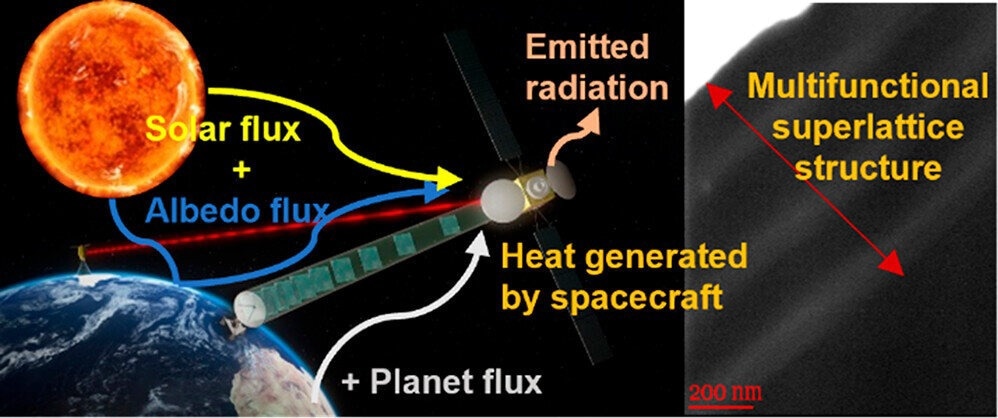Maintaining the temperature of spacecraft within a specific range during their operational lifetime is crucial for ensuring mission success. However, the harsh conditions of space can make this extremely challenging, as large temperature differentials can cause mechanical stress and structural distortions.

Graphical abstract. Image Credit: ACS Nano (2023). DOI: 10.1021/acsnano.2c09737
A recent study published in the journal ACS Nano focuses on this issue by developing a novel thermal control system (TCS) using a lightweight multifunctional nanobarrier structure (MFNS) that could revolutionize how thermal control is managed in spacecraft.
Thermal Control System (TCS): Why is it Important?
Thermal control systems (TCSs) are used to maintain the temperature of spacecraft within a specific range during their operational lifetime. They are important for ensuring optimal performance and mission success of the spacecraft.
Thermal control systems (TCSs) are made up of a combination of passive and active control techniques. Passive TCS methods include using materials and techniques that do not require an external power source to operate. These methods include thin foils, multilayer insulation (MLI), and sun shields, which reflect, absorb, or radiate heat from the spacecraft.
Passive TCS methods are typically used to control the temperature of the spacecraft by managing the heat generated by the spacecraft's systems, as well as the heat that is received from the sun and other external sources.
Active TCS methods, on the other hand, require an external power source to operate. These methods include electrical heaters, cryocoolers, and thermal radiators. Electrical heaters are used to generate heat and keep the spacecraft warm, while cryocoolers remove heat and keep the spacecraft cool.
Limitations in Thermal Management of Spacecrafts
Large satellites often require a hybrid of passive and active control approaches to maintain temperature control within overly narrow margins. However, their implementation is constrained by power and mass constraints, which sometimes result in the termination of mission studies.
Smaller satellites, such as CubeSats, need more compact and lightweight temperature control systems due to size constraints that limit the utilization capability of active systems.
The use of smart electrochromic and thermochromic materials for thermal control in spacecraft has also been explored to realize variable thermal control.
However, these materials require heavy equipment, which can be a constraint for smaller spacecraft. In addition, the thermal emittance of these materials only varies in the infrared spectrum, which may not be sufficient for optimal temperature control.
A Novel TCS Made of Multifunctional Nanobarrier Structure (MFNS)
In this study, the researchers developed a novel thermal control system (TCS) using a lightweight multifunctional nanobarrier structure (MFNS). Moisture and outgassing physical barrier (MOB) is combined with atomic oxygen (AO) and ultraviolet (UV) protection functionality to form the structure.
The MOB works as a barrier to inhibit moisture intrusion and volatile chemical outgassing, while the AO-UV protection capability shields the structure from atomic oxygen and UV rays.
The MFNS is a multilayer protective coating that is ultralight, mechanically and environmentally resistant. It can adjust its optical band gap by building a thermo-mechanically connected multilayer structure on the substrate interfaces with integrated photothermal conversion processes.
The structure can also be applied to a variety of heat-sensitive substrates, including metals and polymers, utilizing a bespoke room-temperature process.
Our new nano barrier is able to not only provide radiation and thermal protection but also harvest energy for use at a later date.
Professor Ravi Silva, Corresponding Author, Director of the Advanced Technology Institute at the University of Surrey
Key Developments of the Research
The study demonstrated that MFNS could generate variable solar absorptivity and stable infrared emissivity characteristics with the potential for self-reconfiguration in a low Earth orbit.
It also showed a significant decrease in equilibrium temperature from around 120 to 60 degrees Celsius when used on carbon fiber-reinforced plastic (CFRP).
The MFNS is lightweight and does not require external power inputs, which is a significant improvement over conventional space-qualified TCSs. This can enable improved architecture concepts for satellites regarding their mass-to-power ratio.
The researchers discovered that a variety of materials might be utilized, with the MFNS serving as a stable framework for adjusting other features. In addition, the MFNS exhibited a photothermal conversion efficiency of up to 96.66 percent.
The technology developed in this research has the potential to be used in a variety of applications. It is anticipated that this technology will also be used to develop more advanced and efficient thermal control systems for spacecraft, which will significantly impact the space industry.
Reference
Delkowski, M. et al. (2023). Multifunctional Nanostructures with Controllable Band Gap Giving Highly Stable Infrared Emissivity for Smart Thermal Management. ACS Nano. Available at: https://doi.org/10.1021/acsnano.2c09737
Disclaimer: The views expressed here are those of the author expressed in their private capacity and do not necessarily represent the views of AZoM.com Limited T/A AZoNetwork the owner and operator of this website. This disclaimer forms part of the Terms and conditions of use of this website.